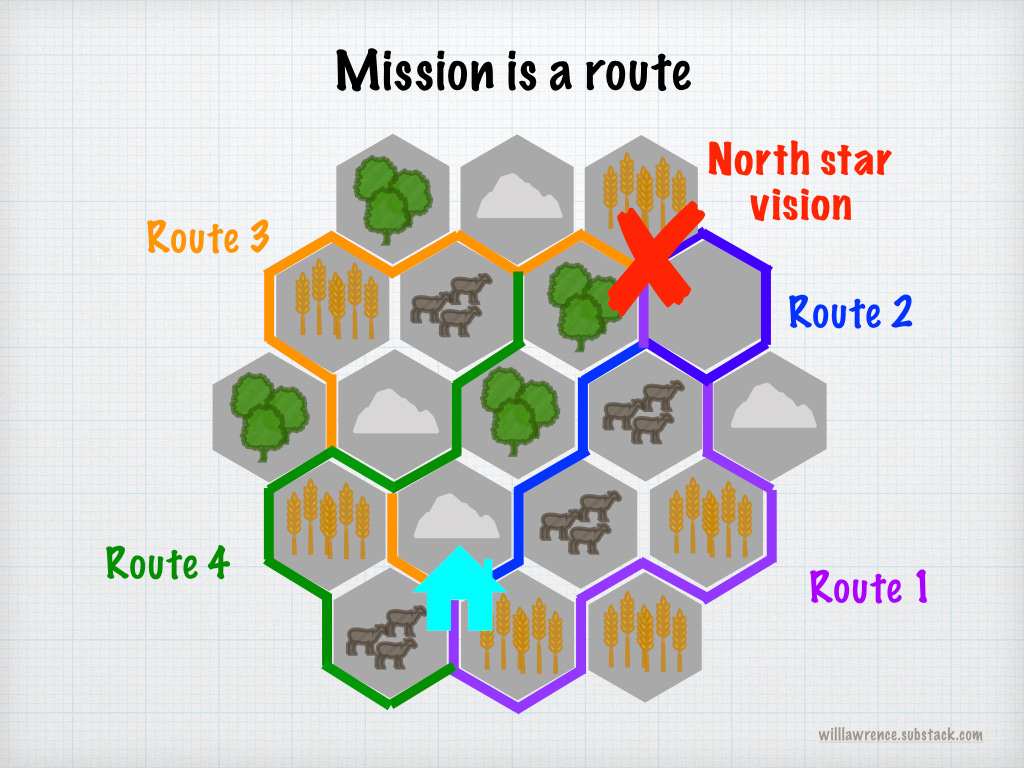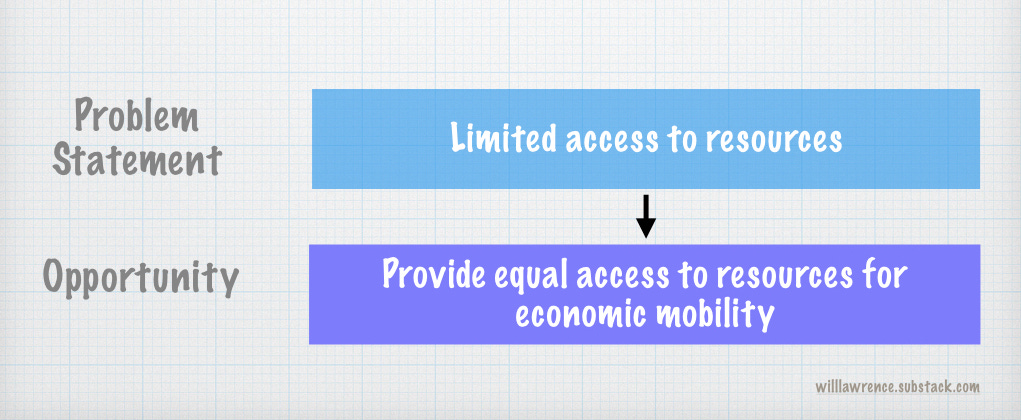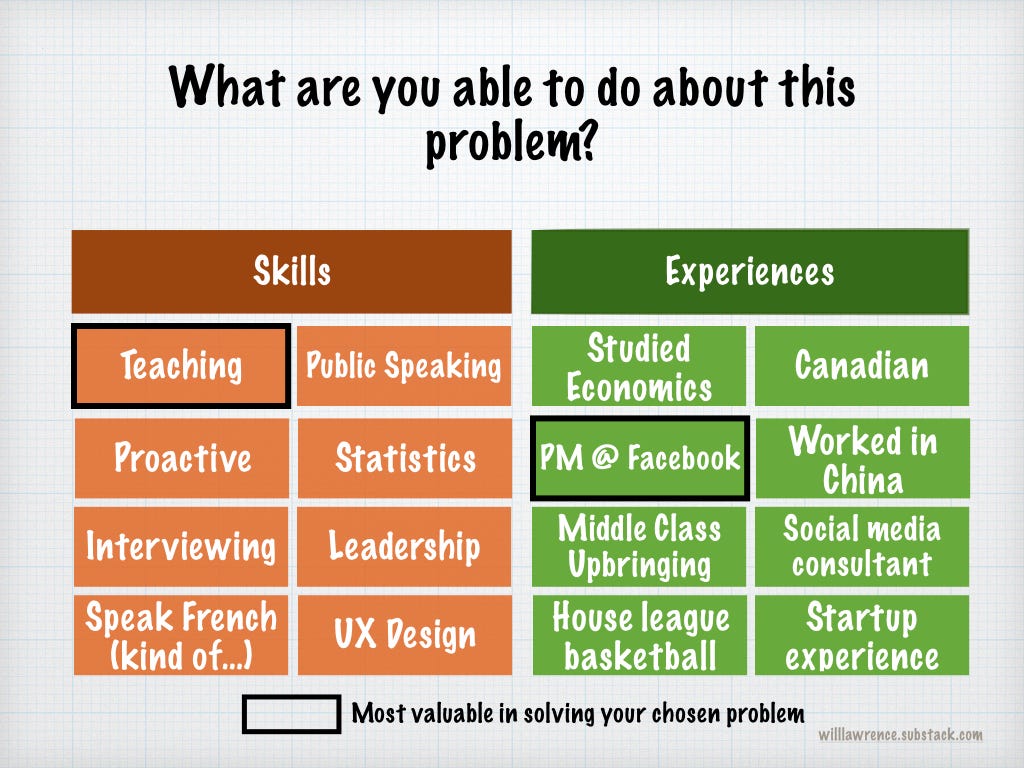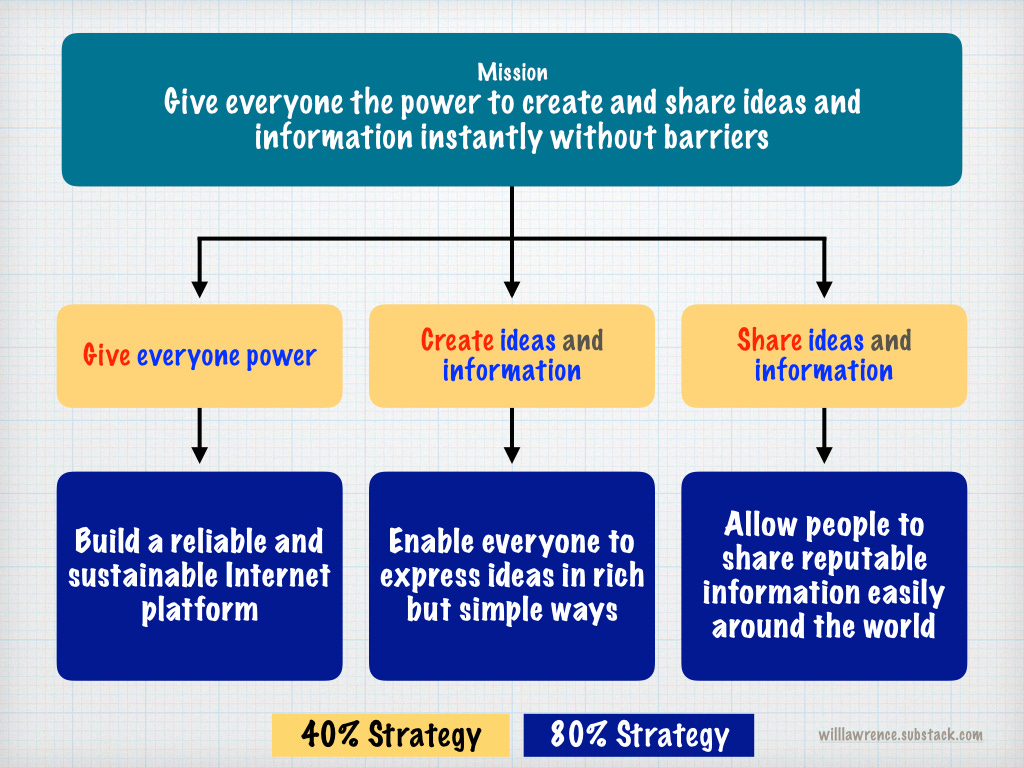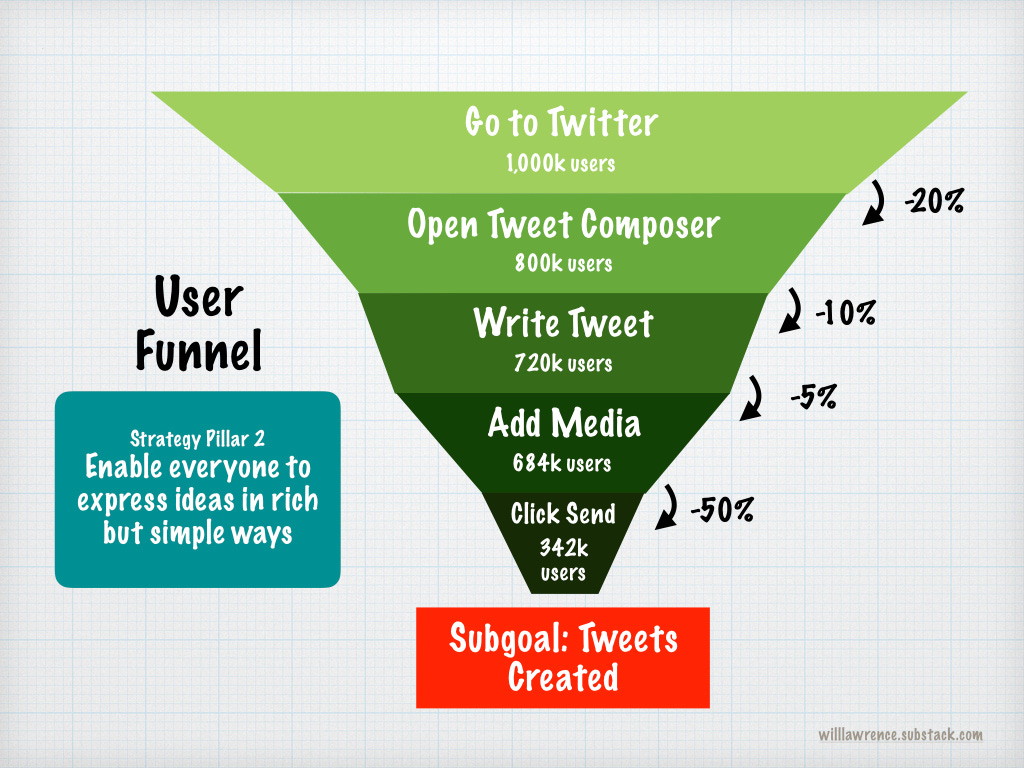A PMs Guide to Product Strategy
An overview of the five core principles of product strategy for product managers
At one level, the responsibilities of the product manager are pretty straightforward. He or she is responsible for evaluating opportunities and determining what gets built and delivered to customers .
- Marty Cagan, Inspired
How do product managers decide what gets built?
I've been a product manager for 1.5 years and I'm still trying to learn how to do this well. Fortunately, I’ve had the chance to work with (and learn from) great PMs during my time at Facebook.
I observed a reoccurring playbook these PMs use to solve problems. Some things I noticed:
No decisions were made in isolation — they were linked to a higher purpose or plan.
All moves were intentional and the team understood why something was being built.
It was easy to decide what to build because the team knew why they were building anything in the first place.
This playbook has a name: product strategy. It’s a master plan for intentionally bringing change to the world over a long period of time.
You’ve probably heard the term product strategy before. But relearning this concept from first principles makes it 10x more useful in practice.
It can help answer many questions that arise during product development:
What should we build next?
How do we know if we're successful?
How can we differentiate from competitors?
But there's no reason to limit this playbook to product management. It can also help navigate tough questions in life:
Should I stay at this job or quit to start writing a novel?
How can I become happier?
What city should I live in?
At the end of this post, I’ll answer these exact questions using product strategy to demonstrate how it can help make principled decisions.
An Overview
Over the last 5 weeks, we've dived into each of the five components of product strategy in detail. Today, I’ll share an overview of the entire process.
If you’d like to dig into the details and work through the exercises, here are the five components with links to their respective deep dives:
Vision - What is the change we want to bring to the world?
Mission - How will we make this vision a reality?
Strategy - What are the levers we will pull to achieve our mission?
Goals - What milestones indicate progress on our strategy?
Tactics - What specific projects can help us achieve our goals?
A Helpful Analogy 🌄
I like to visualize abstract concepts with something I'm familiar with. Luckily, product strategy is a lot like a cross-country road trip.
On a road trip, you choose a destination - usually one that is far off and foreign. You decide on a route to get there and then choose your mode of transportation based on this route - you could fly, drive or even skateboard to your destination! You're also going to need a way to track the progress on your journey (a GPS might help). Finally, you're going to need to do a set of actions to get to your destination - like driving, stopping for lunch and booking hotels along the way.
Here's how these concepts correspond to a product strategy:
I'll build up this analogy as we move along using the 🌄 emoji to refer back to it.
Vision (link) 🌟
🌄 You can't set out on a road trip without a destination in mind. Where is the final destination of your journey? This north star destination is your vision. 🌄
A vision gives you a north star to shoot for. All actions, projects and late-night grinds are in service of getting to this north star.
In a road trip, this is a concrete place (ex. Anchorage, Alaska). When thinking about your long-term plans, however, this is more likely a concept or a world state. Here are vision statements from some great companies as examples:
Great visions share these qualities:
Outcome-oriented - Focus on the desired outcome they want in the world.
No specific tactics - Be flexible on "the how", but never "the why".
Shared purpose - A vision creates unity across thousands of people who are all working to advance this vision.
How do you create a vision?
1) Identify your true passions
1a) List the activities that help you get into a flow state
1b) Ask yourself why you enjoy these activities. Tie your enjoyment to values you may have.
2) Bring the key values you've identified into a single phrase — your vision.
Mission (link) 🛣️
🌄 Once you've decided on a vision, choose a route to get to that vision. There are many potential routes but which route you take depends on the specific assets and knowledge that can help you make the journey. This is called a mission. 🌄
A mission is a chosen route for getting to your north-star vision. It is more actionable than a vision and ties your specific assets to the vision you want to reach.
Great missions share these qualities:
Inspirational - The journey to the vision is long. A mission needs to keep people energized.
Opinionated - Don’t include everything in your mission. Take a stand for the specific problems you care about.
Unique - Be specific about the way you are going to tackle the problem by bringing in your unique assets and experiences.
How do you create a mission?
1) Start at your vision
2) Identify the root problem you want to solve
2a) Use root-case analysis - ask "What are the barriers to reaching your vision?"
2b) Prioritize the root-cause you want to solve
2c) Flip your problem into an opportunity. This framing will help make your mission more actionable and inspiring.
3) Identify what you can do about this problem
4) Combine the root problem you've identified with your assets to land on a mission
Strategy (link) 🚗
🌄 How are you going to traverse this route? You may need to focus on a few things - your mode of transportation, staying healthy and having enough money to name a few! Bucket the items that are essential to successfully achieving your mission into a few pillars. This becomes your strategy. 🌄
Strategy has become a loaded word but at its core, it’s a high-level plan to achieve your mission. Build strategies in a way that can help you start learning from execution quickly (quadrant 1 below).
Great strategies share these qualities:
Imperfect - People get paralyzed creating the perfect strategy. Spending time creating a strategy is the time taken away from learning, experimenting and failing. Spend time focussing on perfect execution instead.
Dynamic - It updates based on new learnings, failures and constraints. This is why it's better to start moving and update your strategy as you go.
Not the starting point - Without vision and mission, the strategy doesn’t achieve anything. You need to know where you're going before you take the first step.
How do you create a strategy?
Note: To make strategy, goals and tactics more widely relevant, I switch from my own personal vision/mission to Twitter’s for the last three pillars. Hope this helps!
1) Start at your mission
2) Build a low fidelity strategy ("a 40% strategy") using the D&A Method
2a) Break down your mission statement into two sections: Definitions and Actions
2b) Add: Definitions + Actions = 40% strategy
3) Add details to create a low fidelity strategy ("an 80% strategy") by deciding how to execute on each prong of the strategy
Goals (link) 🎯
🌄 You'll also need to know if you're making progress on your journey. This is where different measures come in (ex. distance travelled, gas in the tank, days on the road). It is useful to decide checkpoints to know if you're making a progress on your journey. This is the power of goals. 🌄
Goals, like a GPS, can tell you if you’re making progress. But they’re only useful if you’ve already defined a route you want to take (mission) and how you’re going to move along that route (strategy). Imagine using a GPS without a destination in mind or without choosing if you’ll drive or bike to your location — not the most useful!
Great goals share these qualities:
Proxy for value created - Does the thing you’re measuring actually create value? For example, if 1 billion people shared an additional link on Twitter a day, would the world be a better place? Probably not.
Measurable - “If you can’t measure it, you can’t improve it.” - Peter Drucker. The ability to quantify a goal makes it easier to track progress.
Sensitive to Change - Moveable measurement is much more useful at tracking progress because your efforts lead to changes in real-time.
How do you create goals?
1) Start at your mission and strategy
2) Brainstorm goals for your mission and strategy pillars
2a) Avoid jumping directly to a number by brainstorming Human-Language Goals
2b) Kickstart brainstorming by tieing keywords in your mission and strategy to ways of measuring them
3) Prioritize a topline goal (for your mission) and subgoals (for your strategy pillars)
3a) Prioritize against the qualities of a good goal: a proxy for value, measurability and sensitivity to change
Tactics (link) 🏃♂️
🌄 With a goal in mind, it’s time to start moving towards the first one. You may need to get gas and then spend the day behind the wheel on the interstate highway. These actions are tactics. 🌄
Tactics are specific actions you take to make progress towards your mission. If you’ve already created goals, then tactics should be hyper-focussed on moving goals. This allows you to creatively explore ways of solving small problems.
Great tactics share these qualities:
Impact > Cost - The expected impact on your goals exceeds the cost to execute the tactic (resources, time, energy).
Hypothesis Driven - Tactics should be built on a testable hypothesis (ex. making this button bigger will cause more people to tweet).
Executed Perfectly - If your execution is sub-par, you will never know if the tactic worked.
How do you create tactics?
1) Use funnel analysis to visualize the user journey
1a) Map out each step of the journey and note the attrition
1b) Plug-in real data to identify the points of highest friction
1c) Prioritize one point of friction
2) Reduce frictions
2a) Brainstorm tactics to improve the frictions you've identified
2b) Start experimenting with these tactics
Bringing it all together
The principles of product strategy can be deployed to solve all types of problems. It’s robust and can bring clarity to nuanced life decisions.
To demonstrate, let’s revisit the questions we had at the top of this post and apply product strategy to it:
What should we build next?
→ Ideate tactics based on our strategy and goals.
How do we know if we're successful?
→ Success = advancing your mission. We can measure progress towards our mission with a topline goal.
How can we differentiate from competitors?
→ Build a strategy based on our unique mission.
Should I stay at this job or go quit to start writing a novel?
→ Identify which tactic (staying at your job or writing a novel) will advance your subgoal more.
How can I become happier?
→ Proxy happiness with a goal (ex. physical health). Brainstorm the tactics to move this goal.
What city should I live in?
→ Identify which tactic (city) is best aligned with your mission and topline goal.
Start using this playbook to intentionally bring change to the world!
Thank you for reading ☺️. If you want to support Product Life or have any questions, you can like and leave a comment below!








